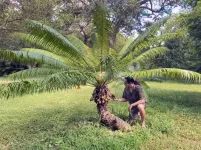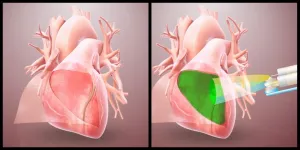Researchers review data on reputed toxins thought to cause neurodegeneration
2021-06-18
(Press-News.org) Identifying the causes of human neurodegenerative diseases is a global research priority, warranting frequent reviews of the accumulating knowledge. In doing just that, biologists from the Plant Physiology Laboratory at the University of Guam and neuroscientists from the Experimental Medicine Program at The University of British Columbia have published an update on the reputed environmental toxins that have been suspected of being involved in mammal neurodegeneration. Their summary was published in April in the book Spectrums of Amyotrophic Lateral Sclerosis, which is available online from the publisher Wiley Blackwell.
A decades-long search for a dementia-causing toxin
Interest in the correlations between environmental toxins and neurodegeneration focused the world's magnifying glass on the island of Guam in the 1950s due to an unexpected increase in cases of neurodegenerative cases among the indigenous CHamoru population. The specific condition that temporarily affected Guam is known as amyotrophic lateral sclerosis-parkinsonism dementia (ALS-PDC) and known locally by the CHamoru term lytico-bodig.
A focus on this isolated cluster of cases led to decades of pursuit of causal toxins found in seeds of Guam's native cycad tree. These seeds were components of the local cuisine at the time, and increased reliance on this form of food starch during World War II was a plausible hypothesis to explain the increase in neurodegeneration cases shortly after the war.
Several factors likely coalesce
An ebb and flow of sequential disappointments has evolved since the 1950s because the identification of a single causal cycad toxin remains elusive.
But these disappointments have been countered by successes. It is now understood that several factors likely coalesce into a synchronized perfect storm to generate an unusual increase in localized neurodegenerative cases, such as what temporarily happened on Guam. These co-factors may include exposure to high doses of the environmental toxin by the most susceptible gender with the most susceptible genes at the most susceptible age, followed by a latency period before the neuronal damage begins to express itself.
The UOG-UBC collaboration has lasted more than two decades, and various members of the team have authored more than 100 journal articles on various aspects of cycad biology during that time. The toxicology of Guam cycad seeds was the subject of 14 of these publications.
"When I began collaborating with UOG, we had the benefit of building on the foundation of decades of research from Guam," said co-author Christopher Shaw, UBC neuroscientist. "We used the fact that no plant scientist had been directly involved in any of the previously published research to secure funds to revisit various issues concerning cycad seed toxins."
Difference between acute and slow-acting toxins
One of the many confusing aspects of this research is that acute toxins, which cause immediate poison reactions following cycad seed ingestion, are distinct from slow-acting toxins, which lead to neurodegeneration.
"The distinctions between these two forms of toxins are often confused, and scientists are constantly reminding the public that many years need to elapse after the exposure to a slow plant toxin before negative health outcomes develop," said Benjamin Deloso, a cycad biologist with UOG.
Claims of cyanide poisoning inaccurate
Another benefit from the marathon pursuit of the causal cycad toxin is that an enormous body of literature has developed that uncovered which biomolecules are not at play.
"This is how science works," Shaw said. "The aggressive empirical look at each candidate toxin was justified and refined the development of superseding hypotheses that were vigorously tested."
For example, cassava roots contain sugar-based molecules that liberate cyanide after ingestion by mammals, and cycad seeds contain similar molecules, but cycad seeds contain no free cyanide and the identified sugar-based cycad molecules in cycads are incapable of liberating toxic levels of cyanide following ingestion by mammals. The meticulous research revealed the claims of cyanide as a potential cycad toxin and that cycad seed consumption could cause cyanide poisoning were inaccurate.
"Throwing around fear-mongering buzzwords, like cyanide, is a classic example of a repetition of false information in order to drive a personal agenda," Deloso said. "There are even petitions being circulated that falsely claim that cycad plants contain cyanide in attempts to force retail nurseries to stop selling cycad plants to pet owners."
The research team contends that scientists are not immune from the mistake of repeating these sorts of false claims about cycads. This tends to happen when scientists get their information from the gray literature or online encyclopedia style websites that are not vetted by cycad experts.
The authors hope that one outcome of their new publication is a decline in the spread of false information about cycad poisoning, as these untruthful statements damage the international community's attempts to improve cycad conservation.
INFORMATION:
Further Reading:
Shaw, C.A. and T.E. Marler. 2021. The Lessons of ALS?PDC - Environmental Factors in ALS Etiology. p. 57-79. In: Spectrums of Amyotrophic Lateral Sclerosis. https://doi.org/10.1002/9781119745532.ch4
[Attachments] See images for this press release:

ELSE PRESS RELEASES FROM THIS DATE:
2021-06-18
According to a recent Finnish study, higher levels of moderate and vigorous physical activity can curb arterial stiffening already in childhood. However, sedentary time or aerobic fitness were not linked to arterial health. The results, based on the ongoing Physical Activity and Nutrition in Children (PANIC) Study conducted at the University of Eastern Finland, were published in the Journal of Sports Sciences. The study was made in collaboration among researchers from the University of Jyväskylä, University of Eastern Finland, the Norwegian School of Sport sciences, and the University of Cambridge.
Arterial stiffening predisposes to heart diseases, ...
2021-06-18
Tokyo, Japan - In Japan, thousands of homes and businesses and hundreds of lives have been lost to typhoons. But now, researchers have revealed that a new flood forecasting system could provide earlier flood warnings, giving people more time to prepare or evacuate, and potentially saving lives.
In a study published this month in Scientific Reports, researchers from The University of Tokyo Institute of Industrial Science have shown that a recently developed flood forecasting system provides much earlier advance warnings of extreme flooding events than current systems. ...
2021-06-18
Germany is a hotspot for dragonflies and damselflies (Odonata) species in Europe, owing to the range of habitats and climates that it provides. While many recent and mostly small-scale studies suggest long-term declines of insect populations in different parts of Europe, studies of freshwater insects - including dragonflies and damselflies - suggest that some species have increased in occurrence. Researchers of iDiv, FSU and UFZ have now provided a nationwide analysis of the occurrence and distribution of dragonflies and damselflies in Germany between 1980 and 2016. For this, they analysed over 1 million occurrence records on 77 species from different regional ...
2021-06-18
The population on Earth is increasingly growing and people are expected to live longer in the future. Thus, better and more reliable therapies to treat human diseases such as Alzheimer's and cardiovascular diseases are crucial. To cope with the challenge of ensuring healthy ageing, a group of international scientists investigated the potential of biosynthesising several polyamines and polyamines analogues with already known functionalities in treating and preventing age-related diseases.
One of the most interesting molecules to study was spermidine, which is a natural product already present in people's blood and an inducer of autophagy that is an essential cellular process for clearing damaged proteins, e.g., misfolded proteins ...
2021-06-18
URBANA, Ill. - For the most accurate accounting of a product's environmental impact, scientists look at the product's entire life cycle, from cradle to grave. It's a grand calculation known as a life cycle assessment (LCA), and greenhouse gas emissions are a key component.
For corn ethanol, most greenhouse gas emissions can be mapped to the fuel's production, transportation, and combustion, but a large portion of the greenhouse gas calculation can be traced right back to the farm. Because of privacy concerns, however, scientists can't access individual farm management decisions such as fertilizer type and rate.
Nitrogen fertilizer data are an important piece of the calculation because a portion ...
2021-06-18
A decade-long study of the most common forearm fracture in older adults revealed that personalized medicine catering to a patient's individual needs and environment, not age or X-rays, should guide treatment options.
Led by a Michigan Medicine physician, the research team examined treatment outcomes over two years for patients who fractured their distal radius, the larger of two bones in the forearm. They found no one-size-fits all method for treating the fracture, which more than 85,000 Medicare beneficiaries sustain annually.
"Traditionally, surgeons look at these broken bones on X-rays, and they have to assess various ways of fixing it based off fracture anatomy and patient age," said Kevin Chung, M.D., study lead and Charles B. G. De ...
2021-06-18
By combining satellite data and digital models, the researchers have shown that coastal overtopping, and consequently the risk of flooding, is set to further accelerate over the 21st century, by up to 50-fold under a high emission global warming scenario, especially in the tropics. This increase is principally caused by a combination of sea level rise and ocean waves.
Low-lying coastal regions host nearly 10% of the world's population. In addition to ongoing erosion and rising sea levels, these areas and their unique ecosystems are facing destructive hazards, including episodic flooding due to overtopping of natural/artificial protection, as in the case of Hurricane Katrina, ...
2021-06-18
Scientists from the Walter Reed Army Institute of Research and Naval Medical Research Center partnered with researchers at the University of Pennsylvania and Acuitas Therapeutics to develop a novel vaccine based on mRNA technology that protects against malaria in animal models, publishing their findings in npj Vaccines.
In 2019, there were an estimated 229 million cases of malaria and 409,000 deaths globally, creating an extraordinary cost in terms of human morbidity, mortality, economic burden, and regional social stability. Worldwide, Plasmodium falciparum is the parasite species which ...
2021-06-18
A staged alert system, designed by scientists and public health officials to guide local policies, helped one city prevent hospital surges and long lockdowns, according to new research published in the journal Nature Communications.
In a new study led by The University of Texas at Austin COVID-19 Modeling Consortium in collaboration with Northwestern University, researchers describe the system that has guided COVID-19 policies in Austin, Texas, for more than a year, helping to safeguard the health care system and avoid costly measures. It tracks the number of new daily COVID-19 hospital admissions and triggers changes in guidance when admissions cross specific threshold values. While using this staged alert system, the Austin metropolitan area has sustained the ...
2021-06-18
A hydrogel that forms a barrier to keep heart tissue from adhering to surrounding tissue after surgery was developed and successfully tested in rodents by a team of University of California San Diego researchers. The team of engineers, scientists and physicians also conducted a pilot study on porcine hearts, with promising results.
They describe their work in the June 18, 2021 issue of Nature Communications.
In rats, the hydrogel prevented the formation of adhesions altogether. In a small pilot study, porcine hearts treated with the hydrogel experienced less severe adhesions that were easier to remove. In addition, the hydrogel did not appear to cause chronic inflammation.
Adhesions--organ tissue sticking to surrounding tissue--are a relatively ...
LAST 30 PRESS RELEASES:
[Press-News.org] Researchers review data on reputed toxins thought to cause neurodegeneration








